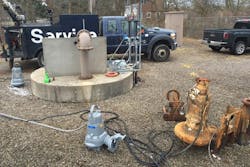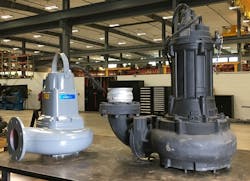The Genesee County (MI) Drain Commissioner, Division of Water & Waste Services (GCDC-WWS) is responsible for the construction and maintenance of the county sanitary sewer collection system and water distribution system. GCDC-WWS owns and operates three wastewater treatment facilities: the Anthony Ragnone Treatment Plant (ARTP), Sanitary Disposal District #3 Treatment Plant, and Sanitary Disposal District #7 Lagoons.
Scope
In 2007 GCDC-WWS completed the construction of its Northeast Extension Sewer Project, which split and rerouted some of the system’s flows. They began reviewing the current status of ten of their major sanitary sewer pumping stations. Pump Station #8, servicing Genesee and Richfield Township’s, was among the stations being considered for rebuilding the existing pumps or replacing them with new units.
Pump Station #8 contained two horizontal dry pit and two submersible pumps installed in 1988. The GCDC-WWS Operations and Maintenance Department has rebuilt the pumps several times over the years. De-ragging of pumps was part of their standard operating procedures when running their station routes. When it became time once again to rebuild the pumps, GCDC-WWS opted to look at newer options. It was also desirable for the new pumps to match the actual flow and head conditions required.
Simply rebuilding pumps did not restore them to their original head conditions and flows. In addition, there were longevity considerations between repairs, ongoing ragging problems, spare parts issues, and service considerations for the older model pumps.
Solution
GCDC-WWS no longer wanted to throw good money at old technology, so they turned to their Xylem distributor and trusted supplier Kennedy Industries for answers and a more permanent solution. Pump Station #8 was the perfect place and time to introduce Xylem’s new Flygt Concertor®, a smart wastewater pumping system that senses the operating conditions of its environment, adapts its performance in real time, and provides feedback to pumping station operators.
There are several reasons Flygt Concertor® technology appealed to them:
• Interchangeability throughout many of their pump stations reduces the number of spare pumps needed in their inventory. This created the ability, in an emergency, to move pumps from a lower priority station to an immediate priority station by simply resetting the pump parameters.
• The Xylem Technology with integrated speed control eliminates the need to purchase variable frequency drives, which was also a selling point as this up valuable space. Flygt Concertor’s built-in technology saved the county time and money by eliminating the need to upgrade controls.
• The county was most impressed with Flygt Concertor’s automatic non-clog reverse function. County personnel were already familiar with the reverse function troubleshooting method because they often had to employ it with their current pumps. But Concertor’s built-in intelligence of the auto reverse function reduces life cycle cost dramatically by not having to send personnel out to the station, thus eliminating the inherent danger involved working with high voltage while switching motor leads around.
The outdated guide rail assemblies were replaced due to extreme corrosion; Kennedy supplied the new rails and the county installed them. Human Machine Interfaces (HMI) were installed for pump feedback, a feature the county did not have with the old pumps at Station #8. Being able to receive and monitor pump running, amp draws, voltage, speed, faults, starts, runtime, daily runtimes, daily KWH usage, and troubleshooting suggestions are all value added features when purchasing the Flygt Concertor.
Results
The new pumps began operating in March 2017 and thus far results have been impressive. There have been zero maintenance callouts. Furthermore, the N-impeller self- cleaning design plus the ability to auto reverse during a “soft clog” has eliminated the need to pull the pumps and clean them on a weekly basis, greatly reducing the risk of personnel injury to the maintenance teams.
On this retrofit project, elimination of the variable frequency drives resulted in a huge reduction in both installation and equipment costs. Additionally, the Energy Minimizer functionality of the integrated pump controls significantly reduces operating energy costs.
Editor's Note: Scranton Gillette Communications and the SGC Water Group are not liable for the accuracy, efficacy and validity of the claims made in this piece. The views expressed in this content do not reflect the position of the editorial teams of Water & Wastes Digest, Water Quality Products and Storm Water Solutions.

